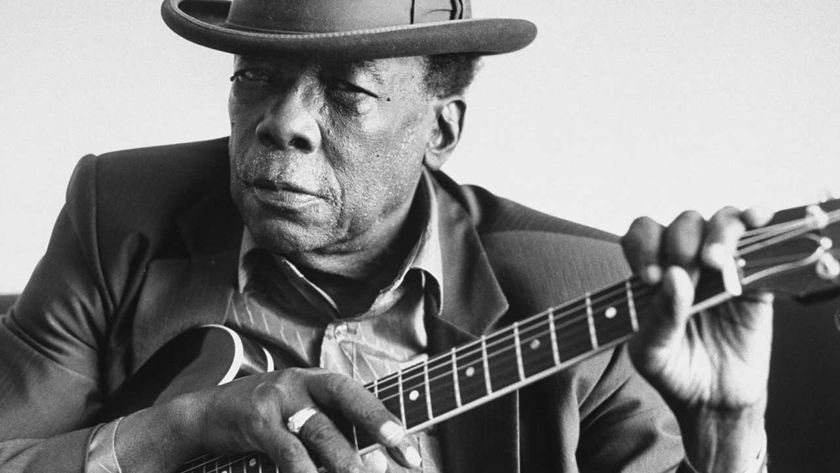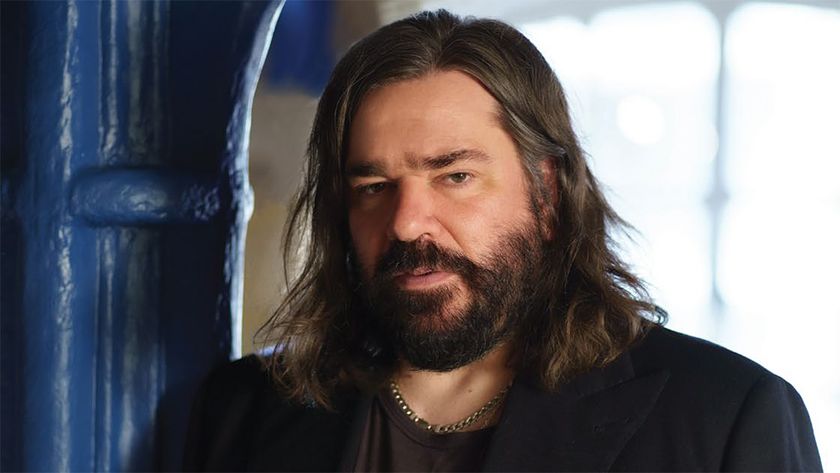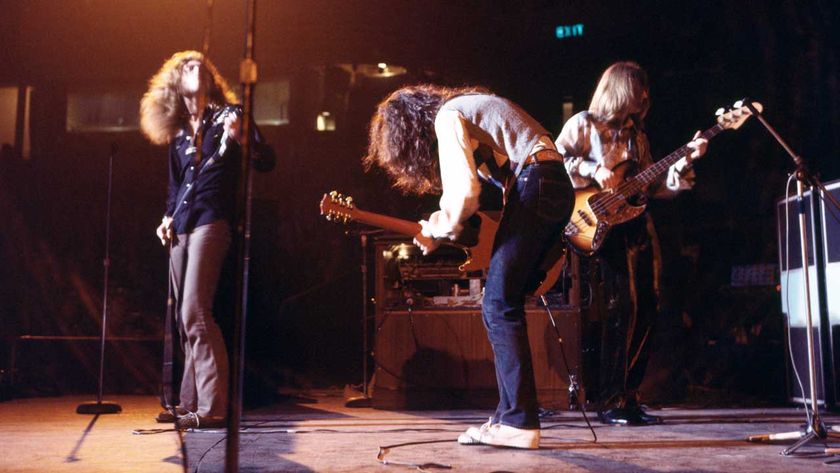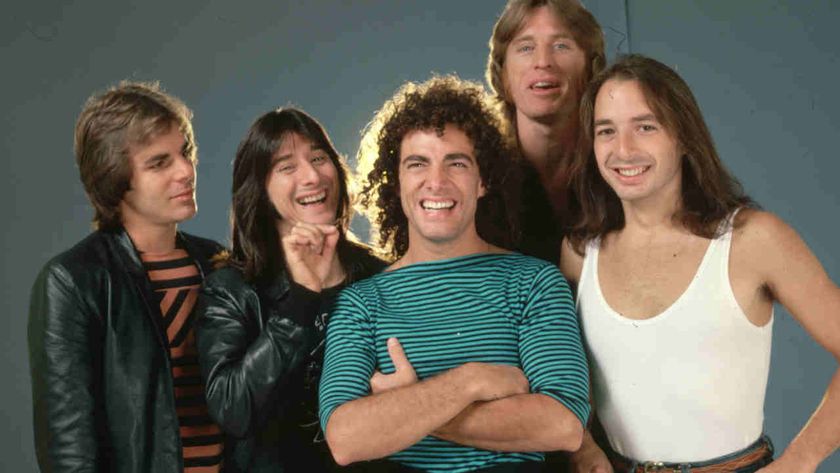It was a dramatic moment when Jimmy Page, Robert Plant and John Paul Jones relinquished the stage and the spotlights beamed onto the beefy, moustachioed man in a red vest, crouched over a glittering drum kit in the shadow of a huge gong.
Audiences already sated by Page’s dazzling guitar and Plant’s emotion-drenched vocals would now be overwhelmed by a virtuoso performance from Led Zeppelin’s mighty drummer. Fans knew that John Henry ‘Bonzo’ Bonham would not stint. He’d draw blood in the ensuing battle with his kit as he unleashed a maelstrom of crashing cymbals and thundering tom toms.
Remember, this was the golden age of drum solos when creative improvisation was encouraged and drummers were stars. In those days vast stadiums echoed to the cataclysmic sounds of Carl Palmer with ELP and Ian Paice with Deep Purple.
Yet however fast they played and whatever effects they used, when it came to transfixing an audience with sheer power, Bonham was unbeatable. There was a primeval element to Bonzo’s playing that touched the soul and quickened the pulse.
Bonham was the natural heir to Ginger Baker, who had developed the concept of the ‘big solo’ with Cream. Indeed, Baker was one of Bonham’s heroes, along with Carmine Appice of Vanilla Fudge and Joe Morello of the Dave Brubeck Quartet.
Moby Dick was first aired on Led Zeppelin II (1969). Jimmy Page established an appropriate riff to launch the number, which kicked off with a battering snare drum figure. John moved from snare to tom tom triplets and congas using his hands. The Baker-esque climax when he switched to sticks still sounds impressive but oddly enough this studio version lacked the fire a ‘live’ audience would encourage.
Back in the 1960s, recording a drum solo on a vinyl long player was nothing unusual. Live, a drum solo was almost expected of every band and had been ever since Gene Krupa became a huge star by pounding on his toms in the 1930s. So when rock emerged the new breed of drummers at first carried on in the Krupa tradition. They played swinging solos, mostly on the toms.
This carried over when British beat groups took up the electric guitar. The clever, immaculate solos of Tony Meehan and Brian Bennett in the Shadows inspired every kid who would later become an international rock star. John Bonham, growing up in the 1950s and early 1960s was immersed in all this, a mixture of rock/ beat group enthusiasm and swing band pulse.
His younger brother Mick points out John’s pre-teen influences – first of all Edmundo Ros, the popular Latin dance band leader. His frilly shirted Latin percussion fascinated John and would turn up in the congas and cowbells of Moby Dick. Mick also points to the fact their dad Jacko was a Harry James band devotee (a certain Buddy Rich being the occasional drummer) and gives two other important pointers.
First John modelled himself initially on Gene Krupa and then slavishly learned Sandy Nelson’s post-Krupa Teen Beat, a worldwide drum solo hit single in 1959. So well before rock became huge, John’s swing credentials were established. Combine this with the blues which all Brit bands played by the mid 60s and you have what Dean Butterworth calls Bonham’s “greasy pocket”.
Prior to John’s emergence there was a handful of decent British rock drummers. Most notable was Baker who’d brought an African, tribal earthiness into rock. He was also the first to blow audiences’ minds by setting up a barraging sixteenth note double kick ostinato – exciting, effective, and done to death ever since.
Moreover, in his solo Moby Dick, Ginger exploited the idea of triplet licks based on the right-hand-left-hand-foot pattern (R-L-F). Ginger grasped the huge potential of this simple move when he saw Sonny Payne of Duke Ellington’s band. And it was this device that Bonzo took and made his own.
By virtue of having a fantastically strong and accurate right foot, Bonzo was able to take this basic motif and permutate it in a dozen ways, using single and double foot strokes to produce flurries of seemingly impossible dexterity. It killed every other drummer – and still does today. Because he didn’t use double kicks he was never tempted to do the straight sixteenth note Ginger/Louie Bellson thing.
Instead he developed the hand-foot triplet coordination which transformed rock drumming – and climaxed every version of Moby Dick thereafter. (In fairness it climaxed Moby Dick as well, but Bonzo took it much further.)
As Iron Maiden’s Nicko McBrain says, “John’s style was cutting edge. John was really the pioneer of the fast right foot, where he put a lot of doubles and played around with triplets on his bass drum and he does that a lot through Moby Dick. What astounded me was the speed and the way he would group the triplet around with the four note group on the top of it.”
The fact his bass drum was Bonzo’s calling card was the big leap from the swing-influenced, postKrupa style. For the swing solo the bottom end was the floor tom. For Bonzo, and for rock thereafter, it was the bass drum. Every important rock drummer since - from Stewart Copeland to Chad Smith - has had a wicked right foot.
Although John’s hands were immense, he wasn’t big on rudiments, so that his snare drum solo work in Moby Dick, although powerful, was never comparable with the Buddy Rich/Louie Bellson lightning snare school. His kick was his great strength, prompting Jimi Hendrix to comment he had “a foot like a rabbit”
The other aspect of Moby Dick which floored drummers and audiences alike was John’s use of his bare hands. One of John’s early drumming friends, Bill Harvey, was mad about Joe Morello, like most British drummers of the 1960s. Bill took John along to see Morello one night in Birmingham. If you listen to Joe’s mammoth solo on Castilian Drums (Dave Brubeck, Live at Carnegie Hall, 1963) you’ll hear many of the same licks Bonzo later used.
Fellow drummer Dave Mattacks remembers Bonzo was also aware of Chico Hamilton’s melodic drumming, while another Brummie buddy, Carl Palmer, mentions Ed Thigpen, Oscar Peterson’s drummer. Note these are all melodic, tasteful, small group jazzers. Bob Henrit (the Kinks and Argent) says many early British rock drummers attempted hand solos, and John’s bassist partner in A Way Of Life - Dave Pegg - remembers him playing hand solos in the mid 60s.
The picture we get from all this is that John not only listened to big band drummers but to the small group jazzers as well. The clincher is immortalised on the live version of Moby Dick, captured at the Albert Hall in 1970 (see Led Zeppelin’s DVD, How The West Was Won). The very first few bars are in three-four time and are a direct quote from be-bop maestro Max Roach’s The Drum Also Waltzes.
John was less impressed by the rock drummers who were his forerunners. He liked the style of the Hollies’ Bobby Elliott and he was certainly influenced by Baker and Appice. But he basically decided that John Bonham would be the one to nail heavy rock.
And nail it he did. He transformed it and he forever defined it which is why he’s held in such high regard still. “He was the drummer’s drummer in just the way he looked when he played his kit,” surmises Nicko. “The flamboyancy, beautiful dynamics and the stunning sound. I always think that Keith Moon was like the Gene Krupa of rock and John Bonham was like the Buddy Rich of rock. I don’t think there’s anyone since come close to the panache and style of his playing.”
As a Melody Maker reporter I often saw John in action, close up on stage at many of their early gigs including the Marquee Club in 1968. All London’s drummers stood in awe, watching the aggressive newcomer from Birmingham. He seemed ferocious, determined but in full control as he assaulted his enormous Ludwig drums. He played like a big band drummer and not just a rock group basher. This wasn’t lost on drummers in audiences who recognised a heavy weight with soul.
Mark Ashton, the young drummer with Rare Bird, a group that hit the charts with Sympathy was standing next to me at the Marquee gig watching Bonham. He laughed ruefully ‘He’s so fucking heavy!’ Mark later gave up drumming as a lost cause and became a singer instead.
As Zeppelin conquered the world it wasn’t long before they relinquished small clubs and were playing events like the 1969 Bath Festival and at London’s Lyceum Ballroom.
It was an even bigger thrill when I was invited to see Led Zeppelin play a rare concert at Carnegie Hall in New York on October 17, 1969. I found myself standing on the very stage where Gene Krupa had played Sing, Sing, Sing back in 1938. At Zeppelin’s afternoon sound check John looked out at the rows of empty plush seats in the famous hall and said "This is it lads. Gene Krupa and Buddy Rich have all played here. So I’d better be good tonight!"
John made good his promise. Once the audience of screaming and whooping New York kids had piled into the building and the show got underway, John seemed to pulsate with energy. As he launched into a 30-minute whirlwind I stood in the wings, next to fellow visitor, Screaming Lord Sutch. His Lordship was speechless as John flew around the drums with astounding dexterity and brute strength. He delivered a high-speed single stroke snare roll that was surely his Carnegie Hall tribute to Buddy Rich.
I never saw Bonham play quite as fast again. Then it was bare hands, beaters, gongs and cymbals for the tumultuous climax. John realised not everybody liked drum solos and to keep their attention he worked out a whole series of permutations, whether it was playing congas or hammering the gong. Yet Moby Dick was never just about noise and bluster. He would begin in a low-key, tentative fashion, toying with a pent up, eager audience, building a series of crescendos.
After that triumphant event Bonzo spent the next five years of his life on the road with Zeppelin coping with endless US tours.
The strain would undoubtedly take its toll on his health and nerves. In July 1970 I went on a five day German tour with the band and could see the effects at first hand. On a bumpy BEA flight to Dusseldorf through thick cloud Bonzo lurched past me, heading for the rear toilet, to be violently sick. A nervous flyer, he was even more worried backstage. The big guy in the leather hat with an appetite for fast cars, suffered from stage fright.
Before every German show he was agitated and couldn’t relax. Although his solos were physically demanding, John was actually more worried about making mistakes during the set and ‘getting the dreaded look’ from the leader. It was his job to cue set tempos, hammer home accents and ensure the breaks were delivered on time.
He certainly coped but his hands became a mass of blisters as the band stormed their way around Germany. One night I was invited to play timbales during Whole Lotta Love. As I nervously joined the band on stage next to Bonzo, I hoped the agitated audience wouldn’t lynch me. It was much safer to sit back and film Bonzo with my Super 8 camera as he blazed away on Moby Dick, hands lacerated and bleeding.
It was huge fun touring with Zeppelin and I thought of chucking in my day job and becoming Zep’s extra percussionist. Then I realised I could never whip up the energy to stand the pace. Nor, sadly could Bonzo. The years of hard playing eventually caught up and he reached journey’s end in 1980, after which the band announced its demise. But thanks to the movie evidence from DVD and The Song Remains The Same we can see John Bonham once more in his prime playing Moby Dick and having a whale of a time.












